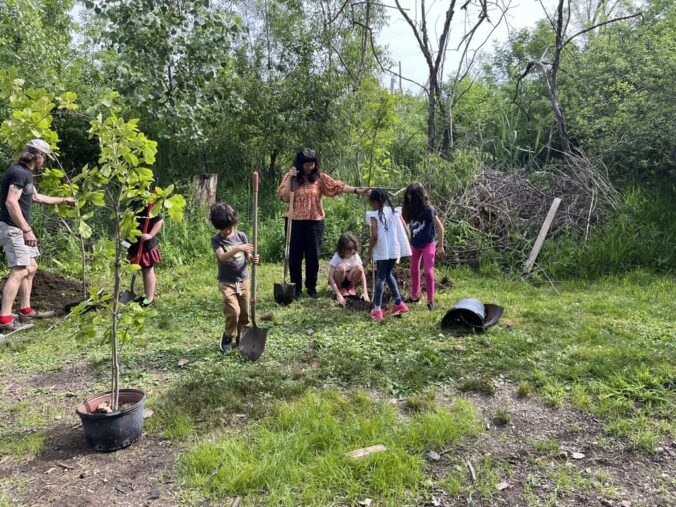In the second to last week of the school year, there’s a lot happening in County Farm Park, on the playgrounds, and in the garden beds around Summers-Knoll School. The Preschoolers have observed ladybugs and caterpillars through their changing life stages until releasing them into the wild on their playground. The Young 5/Kindergarteners also observed the butterfly life cycle and released them this week. The 1st/2nd graders just planted three different types of native Oak Trees (two Swamp Oaks, a Bur Oak, and a Pin Oak), which will increase the biodiversity of our big playground. The 3rd/4th graders have created and planted a Monarch [Butterfly] Waystation just outside their classroom door. And the 5th – 8th graders have been preparing for their performance of A Mid-Summers Knoll Night’s Dream, a modified version of Shakespeare’s A Mid-Summer Night’s Dream, which is being staged on the big playground. In addition, Tim Cernak (2nd grade Christa’s dad) and his team made a huge dent in the removal of invasive species – and planting of native plants – on our big playground this Friday morning.
Oak trees play a vital role in our ecosystem, and Michigan is in need of more oak trees. As Michigan Audubon Society experts explain: “Oaks are essential not only to birds and butterflies but also to many other wildlife species. The acorns produced by oaks — considered ‘hard mast’ — are an important food source for Wild Turkey, Blue Jay, Wood Duck, white-tailed deer, squirrels, mice, and other critters.”
Plants for Monarch Butterflies are also crucial to our ecosystem’s health. “Monarch Waystations are places that provide resources necessary for monarchs to produce successive generations and sustain their migration. Without milkweeds throughout their spring and summer breeding areas in North America, monarchs would not be able to produce the successive generations that culminate in the migration each fall. Similarly, without nectar from flowers these fall migratory monarch butterflies would be unable to make their long journey to overwintering grounds in Mexico. The need for host plants for larvae and energy sources for adults applies to all monarch and butterfly populations around the world.” Now with close to 100 native plants in SK’s newly planted Monarch Waystation, including milkweeds and nectar sources, the garden bed just outside the 3rd/4th grade classroom will serve as an important stopping point for Monarch Butterflies in their long migration from the northern U.S. and Canada to Mexico in the fall and their return from Mexico to the northern U.S. and Canada in spring.
In place-based education, students identify a local problem and then find a way to address it. With the addition of important plants and removal of invasive ones, SK’s grounds are contributing to the increase and sustainability of biodiversity in our local ecosystem. As humans, we are part of these ecosystems we are trying to protect; it’s a mutually beneficial endeavor – the plants that grow here support other living things, including the people who care for this land. Thank you, everyone, who has contributed to the restoration and preservation of this land.
